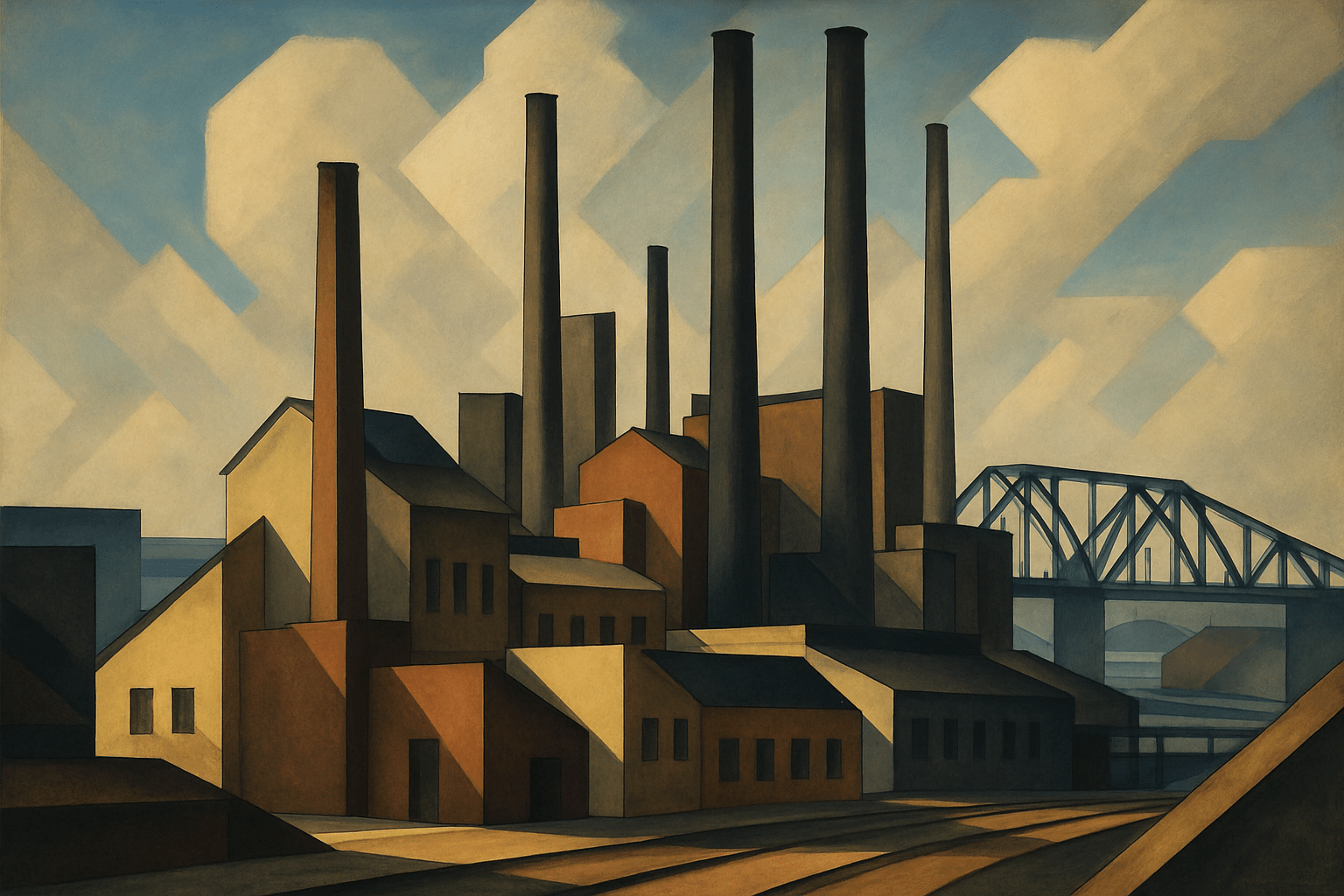
Precisionism
Precisionism was an art movement that began in the early 20th century in the United States. The style is characterized by clean lines, geometric shapes, and a focus on accuracy and precision. Precisionist artists sought to depict the modern world in a realistic and accurate way, often through the use of industrial and architectural subjects.
AOI thinking about Precisionism [+_~]-/
Overview and Quickfacts
Precisionism was an art movement that emerged in the United States in the early 20th century. The style is characterized by clean lines, geometric forms, and a focus on industrial subjects. Precisionist artists sought to convey the precision and order of the modern world through their work.
Can understand it also, as:
Precisionism is a movement in art characterized by its clean lines, lack of ornamentation, and overall geometric feel.
Other words that may be used to describe Precisionism include: Cubism, Futurism, Constructivism, and De Stijl.
Categorize it as:
Impressionism, Modernism
.: Dreaming :.
holds a HAIKU for the art style
:. Thought is power .:
Detailed Description
Precisionism was an art movement that emerged in the early 20th century in the United States. It was characterized by its clean lines, geometric forms, and accurate depictions of scenes from modern life. Precisionist artists sought to capture the essence of their subjects without superfluous detail. They believed that art should be based on precise observation and exactitude, and that it should be free of any expressive or emotional content. Some of the most famous Precisionist artists include Charles Sheeler, Georgia O’Keeffe, and Charles Demuth. Sheeler’s paintings often featured scenes of American industry, such as his famous work “American Landscape” (1930), which depicted the Ford Motor Company’s River Rouge Plant in Michigan. O’Keeffe’s Precisionist works include her series of paintings of New York City skyscrapers, such as “City Night” (1926). Demuth’s most famous Precisionist painting is “The Figure Five in Gold” (1928), which depicts a row of five numbers in a precise, geometric arrangement. Precisionism was one of the first truly American art movements, and its influence can still be seen in many works of art today.
.. beep, beep, beep ..
<START OF TRANSMISSION>
1.Precisionism was an artistic movement that emerged in the United States after World War I 2. It was characterized by its clean lines, geometric forms, and depiction of modern industrial scenes 3. The movement developed out of Cubism and Futurism, and its leading exponents included Charles Sheeler and Charles Demuth 4. Precisionist paintings often featured urban landscapes or scenes of modern life, rendered with a high degree of realism 5. The style was also sometimes referred to as American Cubism or Cubist-Realism 6. Precisionism had a strong influence on subsequent American art movements, including Abstract Expressionism and Pop Art 7. The movement began to lose momentum in the late 1920s, and by the 1930s it had largely dissipated 8. However, its legacy can still be seen in the work of many contemporary artists 9. Here are 20 facts about Precisionism. 1. Precisionism was an artistic movement that emerged in the United States after World War I. 2. It was characterized by its clean lines, geometric forms, and depiction of modern industrial scenes. 3. The movement developed out of Cubism and Futurism, and its leading exponents included Charles Sheeler and Charles Demuth. 4. Precisionist paintings often featured urban landscapes or scenes of modern life, rendered with a high degree of realism. 5. The style was also sometimes referred to as American Cubism or Cubist-Realism. 6. Precisionism had a strong influence on subsequent American art movements, including Abstract Expressionism and Pop Art. 7. The movement began to lose momentum in the late 1920s, and by the 1930s it had largely dissipated. 8. However, its legacy can still be seen in the work of many contemporary artists. 9. Some of the most famous Precisionist paintings include Charles Sheeler's "American Landscape" (1930) and Charles Demuth's "My Egypt" (1927). 10. Precisionism was not limited to painting; it also encompassed sculpture, photography, architecture, and other forms of art. 11. The movement was named for its focus on precise, realistic depictions of its subjects, as opposed to the more abstract style of Cubism. 12. While Precisionism is often seen as an American movement, its roots can actually be traced back to Europe, specifically the work of French artists such as Jean Metzinger and Albert Gleizes. 13. One of the defining characteristics of Precisionist art is its use of geometric forms and shapes. 14. This is often seen as a reaction against the more organic, curvilinear forms of earlier art movements such as Art Nouveau. 15. Another key element of Precisionist paintings is their use of light and shadow to create a sense of depth and volume. 16. The artists associated with Precisionism were also interested in depicting the modern world, and many of their paintings feature scenes of factories, trains, and other industrial subjects. 17. While Precisionism is often seen as a purely American movement, it actually had a significant impact on the development of European art in the 1920s and 1930s. 18. Many European artists, including Pablo Picasso and Georges Braque, were influenced by the Precisionist style. 19. In the United States, Precisionism was partially a reaction against the more sentimental style of American Regionalism. 20. Regionalist artists such as Thomas Hart Benton and Grant Wood were popular in the 1920s and 1930s, but their work was largely overshadowed by the more modernist Precisionist movement.
<EOF>
.. robbel bob
Visual Examples from our image gallery
Coming soon, we are so slow .. might never come
Artists, Paintings, and more
(be aware, can be highly speculative)
Artists (be aware, speculation possible):
1. Charles Demuth (1883-1935) 2. Charles Sheeler (1883-1965) 3. Paul Strand (1890-1976) 4. Georgia O’Keeffe (1887-1986) 5. Stuart Davis (1892-1964) 6. Charles Burchfield (1893-1967) 7. Edward Hopper (1882-1967) 8. John Marin (1870-1953) 9. Yasuo Kuniyoshi (1889-1953) 10. Charles Sheeler (1883-1965) 11. Max Weber (1881-1961) 12. Preston Dickinson (1891-1930) 13. Gerald Murphy (1888-1964) 14. Charles Demuth (1883-1935) 15. Ralston Crawford (1906-1978) 16. Arthur Dove (1880-1946) 17. Marsden Hartley (1877-1943) 18. Charles Sheeler (1883-1965) 19. Joseph Stella (1877-1946) 20. Charles Demuth (1883-1935) 21. Precisionism 22. Charles Sheeler (1883-1965) 23. Charles Demuth (1883-1935) 24. Georgia O’Keeffe (1887-1986) 25. Charles Sheeler (1883-1965) 26. Charles Demuth (1883-1935) 27. Charles Sheeler (1883-1965) 28. Charles Demuth (1883-1935) 29. Charles Sheeler (1883-1965) 30. Charles Demuth (1883-1935)
Artworks (be aware, speculation possible)
1. Charles Sheeler, American Landscape (1931) 2. Charles Sheeler, Doylestown House (1935) 3. Charles Sheeler, Cityscape (1940) 4. Charles Sheeler, Power Plant (1942) 5. Charles Sheeler, River Rouge Plant (1927) 6. Georgia O’Keeffe, City Night (1926) 7. Georgia O’Keeffe, From the River, No. 1 (1927) 8. Georgia O’Keeffe, White Place with Blue (1927) 9. Georgia O’Keeffe, Black Mesa Landscape, New Mexico / Out Back of Marie’s II (1930) 10. Georgia O’Keeffe, Road to Santa Fe (1931) 11. Georgia O’Keeffe, Ranchos Church No. 1 (1931) 12. Georgia O’Keeffe, Grey Line with Black, Blue and Yellow (1923) 13. Georgia O’Keeffe, Black Iris III (1926) 14. Georgia O’Keeffe, White Flower No. 1 (1927) 15. Georgia O’Keeffe, Red Poppy (1927) 16. Georgia O’Keeffe, Black Iris II (1927) 17. Georgia O’Keeffe, Oriental Poppies (1928) 18. Georgia O’Keeffe, Ram’s Head White Hollyhock-Hills (1928) 19. Georgia O’Keeffe, Jack-in-the-Pulpit No. III (1930) 20. Georgia O’Keeffe, Pelvis with Moon (1932) 21. Georgia O’Keeffe, White Rose with Larkspur (1932) 22. Georgia O’Keeffe, Black Cross, New Mexico (1929) 23. Georgia O’Keeffe, Cow’s Skull: Red, White, and Blue (1931) 24. Georgia O’Keeffe, Red and Yellow Cliffs (1932) 25. Georgia O’Keeffe, Petunia No. 2 (1932) 26. Georgia O’Keeffe, Jimson Weed/White Flower No. 1 (1932) 27. Georgia O’Keeffe, White Hollyhock-Hills (1933) 28. Georgia O’Keeffe, Black Rock Desert, Nevada (1934) 29. Georgia O’Keeffe, Mountain in New Mexico (1935) 30. Georgia O’Keeffe, Skull with Pink Roses (1936)
Epoch
Precisionism was an art movement that lasted from roughly 1915 to 1925.
AI ART RESSOURCES (AKA, well Tools)
Helping tools -> predefined search links on other pages:











